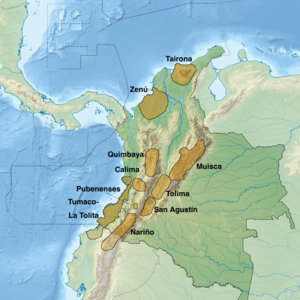
The pre-Columbian cultures of Colombia refers to the ancient cultures and civilizations that inhabited Colombia before the Spanish Conquest in the 16th century.

The pre-Columbian cultures of Colombia refers to the ancient cultures and civilizations that inhabited Colombia before the Spanish Conquest in the 16th century.
The population of these Pre-Columbian cultures in the Modern-Day territory of Colombia is estimated to have been around 7-8 million. [1] Around half of them, or around 2 to 3 million were Muiscas located in Andean highlands, with the population being concentrated in a similar way to Modern-Day Colombia. [2] [3] Lower estimates number the Pre-Columbian population at just around 3 million people whereas higher estimates place the population at 10-12 million people.
Owing to its location, the present territory of Colombia was a corridor of early human migration from Mesoamerica and the Caribbean to the Andes and Amazon basin. The oldest archaeological finds are from the Pubenza and El Totumo sites in the Magdalena Valley 100 kilometres (62 mi) southwest of Bogotá. [4] These sites date from the Paleoindian period (18,000–8000 BCE). At Puerto Hormiga and other sites, traces from the Archaic Period (~8000–2000 BCE) have been found. Vestiges indicate that there was also early occupation in the regions of El Abra and Tequendama in Cundinamarca. The oldest pottery discovered in the Americas, found at San Jacinto, dates to 5000–4000 BCE. [5]
Indigenous people inhabited the territory that is now Colombia by 12,500 BCE. Nomadic hunter-gatherer tribes at the El Abra, Tibitó and Tequendama sites near present-day Bogotá traded with one another and with other cultures from the Magdalena River Valley. [6] Between 5000 and 1000 BCE, hunter-gatherer tribes transitioned to agrarian societies; fixed settlements were established, and pottery appeared. Beginning in the 1st millennium BCE, groups of Amerindians including the Muisca, Zenú, Quimbaya, and Tairona developed the political system of cacicazgos with a pyramidal structure of power headed by caciques.
Most of the Amerindians practiced agriculture and the social structure of each indigenous community was different. Some groups of indigenous people such as the Caribs lived in a state of permanent war, but others had less bellicose attitudes. [7]
There was no dominant culture in the pre-Columbian Colombia. Most of the aboriginal groups belonged to one of 3 major linguistic groups (Arawak, Carib, and Chibcha) and were part of a patchwork of several cultures and subcultures. These indigenous peoples developed the cultivation of yucca in the lower elevations, corn at middle altitudes, and potatoes in the highlands. They practiced ceramic pottery and other crafts, with important achievements in the working of gold, as the use of “tumbaga”, an alloy of gold and copper that facilitated the work of the artisan. [8] [9]
None of the native peoples developed a system of writing comparable to that of the Mayas, nor a native empire such as that of the Aztecs or Incas. By 1500, the most advanced of the indigenous peoples were the Taironas and the Muiscas. [8]

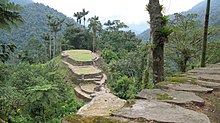

The San Agustín culture inhabited the upper Magdalena region in what is today the Huila Department, in central Colombia. This culture is recognized by its megalithic statues, which were created for religious use. The Tierradentro Archaeological Site was located within the boundaries of this culture. [9]
The Tumaco culture was located in southwest Colombia (Department of Nariño), in the border with Ecuador. It was characterized by their pottery work, which was mainly sculptural. [9]
The Tolima culture inhabited current-day Tolima Department in central Colombia. It's recognized by their goldsmith and pottery. [9]
In southwestern Colombia (department of Nariño), the Nariño culture is recognized by their pottery, emphasizing the negative painting or positive bicolor. [9]
In western Colombia (department of Valle del Cauca), the Calima culture took advantage of its location in one of the main natural ways of communication between the Pacific Coast and the valley of the Cauca River, which promoted the flourishing of a culture characterized by its goldsmith. [9]
The Sinú or Zenú culture was located in northwest Colombia (departments of Sucre and Córdoba) and its recognized by their utilitarian and ritual ceramics and goldsmith in which they combined several techniques. [9] They also did a system of drainage channels to control floodings. [10]
The Quimbaya inhabited regions of the Cauca River Valley between the Western and Central Ranges of the Colombian Andes (current-day departments of Caldas, Risaralda and Quindío). This culture is recognized by their goldsmith, which, among other things, produced poporos (bottles for storing lime used in chewing of coca leaves) of gold. [11] [8] [9]
The Tairona inhabited northern Colombia in the isolated mountain range of Sierra Nevada de Santa Marta (current Magdalena Department, northern Colombia). This culture is recognized by their goldsmith, their pottery and their stone constructions in the slopes of the mountains, like Ciudad Perdida ("The Lost City"). [12] [8] [9]
The Muisca inhabited mainly the area of what is now Bogotá and the departments of Boyacá and Cundinamarca in central Colombia, where they formed the Muisca Confederation. They farmed corn, potato, quinoa and cotton, and traded gold, emeralds, blankets, ceramic handicrafts, coca and especially rock salt with neighboring nations. Among Muisca goldsmith, is remarkable the fabrication of Tunjos, anthropomorphic figurines used for ritual purposes. [9]
| Name | Language | Language Family | Location | Department | Source |
|---|---|---|---|---|---|
| Guanebucán | Guanebucán (perhaps a dialect of Wayuu) | Arawakan | Around Ríohacha | [13] |
The history of Colombia includes its settlement by indigenous peoples and the establishment of agrarian societies, notably the Muisca Confederation, Quimbaya Civilization, and Tairona Chiefdoms. The Spanish arrived in 1499 and initiated a period of annexation and colonization, ultimately creating the Viceroyalty of New Granada, with its capital at Bogotá. Independence from Spain was won in 1819, but by 1830 the resulting "Gran Colombia" Federation was dissolved. What is now Colombia and Panama emerged as the Republic of New Granada. The new nation experimented with federalism as the Granadine Confederation (1858) and then the United States of Colombia (1863) before the Republic of Colombia was finally declared in 1886. A period of constant political violence ensued, and Panama seceded in 1903. Since the 1960s, the country has suffered from an asymmetric low-intensity armed conflict which escalated in the 1990s but decreased from 2005 onward. The legacy of Colombia's history has resulted in a rich cultural heritage, and Colombia's geographic and climatic variations have contributed to the development of strong regional identities.

The Muisca are an indigenous people and culture of the Altiplano Cundiboyacense, Colombia, that formed the Muisca Confederation before the Spanish conquest. The people spoke Muysccubun, a language of the Chibchan language family, also called Muysca and Mosca. They were encountered by conquistadors dispatched by the Spanish Empire in 1537 at the time of the conquest. Subgroupings of the Muisca were mostly identified by their allegiances to three great rulers: the hoa, centered in Hunza, ruling a territory roughly covering modern southern and northeastern Boyacá and southern Santander; the psihipqua, centered in Muyquytá and encompassing most of modern Cundinamarca, the western Llanos; and the iraca, religious ruler of Suamox and modern northeastern Boyacá and southwestern Santander.
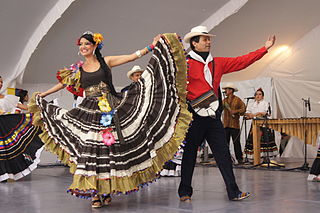
Many aspects of Colombian culture can be traced back to the early culture of Spain of the 16th century and its collision with Colombia's native civilizations. The Spanish brought Catholicism, the feudal encomienda system, and a caste system that favored European descendants.

The Museum of Gold is an archaeology museum located in Bogotá, Colombia. It is one of the most visited touristic highlights in the country. The museum receives around 500,000 tourists per year.

Tairona or Tayrona was a Pre-Columbian culture of Colombia, which consisted in a group of chiefdoms in the region of Sierra Nevada de Santa Marta in present-day Cesar, Magdalena and La Guajira Departments of Colombia, South America, which goes back at least to the 1st century AD and had significant demographic growth around the 11th century.

Indigenous peoples of Colombia are the ethnic groups who have inhabited Colombia since before the Spanish colonization of Colombia, in the early 16th century.

A Poporo is a device used by indigenous cultures in present and pre-Columbian South America for storage of small amounts of lime produced from burnt and crushed sea-shells. It consists of two pieces: the receptacle, and the lid which includes a pin that is used to carry the lime to the mouth while chewing coca leaves. Since the chewing of coca is sacred for the indigenous people, the poporos are also attributed with mystical powers and social status.

The Spanish conquest of New Granada refers to the conquest by the Spanish monarchy of the Chibcha language-speaking nations of modern day Colombia and Panama, mainly the Muisca and Tairona that inhabited present-day Colombia, beginning the Spanish colonization of the Americas. It is estimated that around 5 to 8 million people died as a result of Spanish Conquest, either by disease or direct conflict, this is roughly around 80-90% of the Pre-Columbian population of Colombia.

The Quimbaya (/kɪmbaɪa/) were a small indigenous group in present-day Colombia noted for their gold work characterized by technical accuracy and detailed designs. The majority of the gold work is made in tumbaga alloy, with 30% copper, which colours the pieces.

The Bogotá savanna is a montane savanna, located in the southwestern part of the Altiplano Cundiboyacense in the center of Colombia. The Bogotá savanna has an extent of 4,251.6 square kilometres (1,641.6 sq mi) and an average altitude of 2,650 metres (8,690 ft). The savanna is situated in the Eastern Ranges of the Colombian Andes.

Bacatá is the name given to the main settlement of the Muisca Confederation on the Bogotá savanna. It mostly refers to an area, rather than an individual village, although the name is also found in texts referring to the modern settlement of Funza, in the centre of the savanna. Bacatá was the main seat of the zipa, the ruler of the Bogotá savanna and adjacent areas. The name of the Colombian capital, Bogotá, is derived from Bacatá, but founded as Santafe de Bogotá in the western foothills of the Eastern Hills in a different location than the original settlement Bacatá, west of the Bogotá River, eventually named after Bacatá as well.
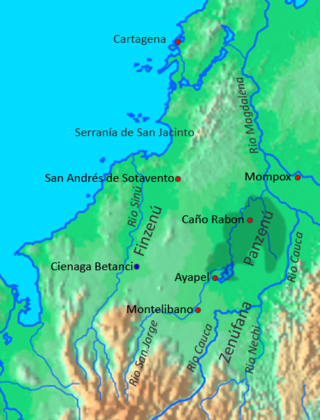
The Zenú or Sinú is a pre-Columbian culture in Colombia, whose ancestral territory comprises the valleys of the Sinú and San Jorge rivers as well as the coast of the Caribbean around the Gulf of Morrosquillo. These lands lie within the departments of Córdoba and Sucre.

Quimbaya artifacts refer to a range of primarily ceramic and gold objects surviving from the Quimbaya civilisation, one of many pre-Columbian cultures of Colombia inhabiting the Middle Cauca River valley and southern Antioquian region of modern-day Colombia. The artifacts are believed to have originated during the Classical Quimbaya period 500 BC–600 AD.
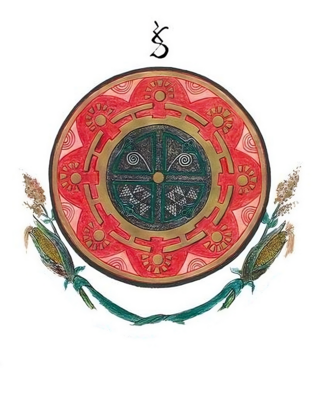
The Muisca Confederation was a loose confederation of different Muisca rulers in the central Andean highlands of what is today Colombia before the Spanish conquest of northern South America. The area, presently called Altiplano Cundiboyacense, comprised the current departments of Boyacá, Cundinamarca and minor parts of Santander.

The Herrera Period is a phase in the history of Colombia. It is part of the Andean preceramic and ceramic, time equivalent of the North American pre-Columbian formative and classic stages and age dated by various archaeologists. The Herrera Period predates the age of the Muisca, who inhabited the Altiplano Cundiboyacense before the Spanish conquest of the Muisca and postdates the prehistory of the region in Colombia. The Herrera Period is usually defined as ranging from 800 BCE to 800 CE, although some scholars date it as early as 1500 BCE.

Tequendama is a preceramic and ceramic archaeological site located southeast of Soacha, Cundinamarca, Colombia, a couple of kilometers east of Tequendama Falls. It consists of multiple evidences of late Pleistocene to middle Holocene population of the Bogotá savanna, the high plateau in the Colombian Andes. Tequendama was inhabited from around 11,000 years BP, and continuing into the prehistorical, Herrera and Muisca periods, making it the oldest site of Colombia, together with El Abra, located north of Zipaquirá. Younger evidences also from the Herrera Period have been found close to the site of Tequendama in Soacha, at the construction site of a new electrical plant. They are dated at around 900 BCE to 900 AD.

This article describes the economy of the Muisca. The Muisca were the original inhabitants of the Altiplano Cundiboyacense, the high plateau in the Eastern Ranges of central present-day Colombia. Their rich economy and advanced merchant abilities were widely known by the indigenous groups of the area and described by the Spanish conquistadores whose primary objective was the acquisition of the mineral resources of Tierra Firme; gold, emeralds, carbon, silver and copper.

Marianne Vere Cardale de Schrimpff is a Colombian anthropologist, archaeologist, academic and writer.
Aguazuque is a pre-Columbian archaeological site located in the western part of the municipality Soacha, close to the municipalities Mosquera and San Antonio del Tequendama in Cundinamarca, Colombia. It exists of evidences of human settlement of hunter-gatherers and in the ultimate phase primitive farmers. The site is situated on the Bogotá savanna, the relatively flat highland of the Altiplano Cundiboyacense close to the present-day course of the Bogotá River at an altitude of 2,600 metres (8,500 ft) above sea level. Aguazuque is just north of another Andean preceramic archaeological site; the rock shelter Tequendama and a few kilometres south of Lake Herrera. The artefacts found mostly belong to the preceramic period, and have been dated to 5025 to 2725 BP. Thus, the younger finds also pertain to the later ceramic Herrera Period. There were some difficulties in dating of the uppermost layer due to modern agricultural activity in the area; the sediments of the shallower parts were disturbed.

This article describes the art produced by the Muisca. The Muisca established one of the four grand civilisations of the pre-Columbian Americas on the Altiplano Cundiboyacense in present-day central Colombia. Their various forms of art have been described in detail and include pottery, textiles, body art, hieroglyphs and rock art. While their architecture was modest compared to the Inca, Aztec and Maya civilisations, the Muisca are best known for their skilled goldworking. The Museo del Oro in the Colombian capital Bogotá houses the biggest collection of golden objects in the world, from various Colombian cultures including the Muisca.